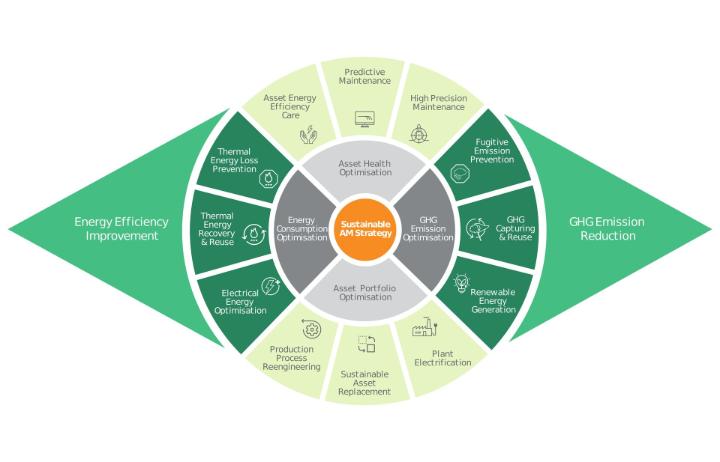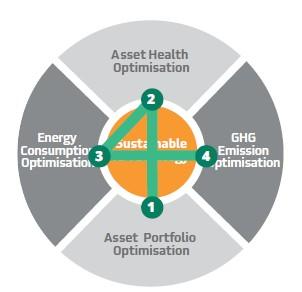Central to this project was the development of a framework in which all aspects of
Sustainable Asset Management are logically presented. The MORE4Sustainability
Framework provides an overview of the measures that the Maintenance and Asset
Management organisation can take to contribute to the company’s sustainability
goals, focusing on Energy Efficiency Improvement on the one hand and GHG
Emission Reduction on the other.

© 2025 - CC BY-NC-ND 4.0
This MORE4Sustainability Framework consists of four levels:
- Strategic level (the orange area) where the company’s sustainability strategy is translated into the Asset Management strategy. This includes mission, vision, and relevant laws and regulations.
- Tactical level (the gray area) describes four quadrants focused on optimisation: Asset Portfolio Optimisation, Asset Health Optimisation, Energy Consumption Optimisation, and GHG Emission Optimisation. These quadrants set the right direction and provide a basis for working on sustainability optimisation and integrating best practices.
- Operational level (the areas in lime and dark green) in which twelve focus areas are defined that are elaborated into practices and methods.
- The fourth level describes the impact of the measures (the green areas on the left and right) on the two sustainability goals: Energy Efficiency Improvement and GHG Emission Reduction.
The four quadrants also entail a specific sequence that adds a meaningful new dimension to the “4” in the project name MORE4Sustainability.

1. Asset Portfolio Optimisation, with a focus on sustainability for production, involves strategically managing a company’s portfolio of physical assets to achieve environmental, social and economic sustainability goals. It also involves monitoring sustainability risks throughout the asset life cycle, making optimal decisions to replace assets, and defining and applying internal sustainability criteria.
2. Asset Health Optimisation, for sustainability reasons at the tactical level, involves implementing specific strategies, IT systems, management systems and actions aimed at improving asset condition, performance and lifespan, while minimising environmental impact and resource consumption. It also involves using data, technology and analytics to monitor, assess and optimise the health and performance of assets throughout their life cycle.
3. Energy Consumption Optimisation refers to the process of maximising energy efficiency and minimising energy waste in various systems, processes and activities within an organisation or facility. The goal of Energy Consumption Optimisation is to achieve the desired level of performance or output with as little energy consumption as possible.
4. GHG Emission Optimisation, for sustainability reasons at the tactical level, involves implementing specific strategies and actions aimed at minimising greenhouse gas (GHG) and other pollutant emissions generated during production processes. By implementing GHG Emission Optimisation strategies, organisations can reduce their carbon footprint, improve sustainability performance and contribute to a cleaner, greener future.
The order of these quadrants from 1 to 4 is also the sequence in which these sustainability measures should logically be implemented. It is advisable to first bring the asset portfolio in order and replace non-sustainable installations with sustainable ones. Subsequently, the sustainability of the machines can be improved through proper maintenance and alignment, as this will result in lower energy consumption. Step 3 involves optimising energy consumption. Once this is in place, steps can be taken in the final phase to reduce emissions, for example, through CO₂ storage or reuse or the installation of wind turbines.